72nd New York Volunteer Infantry Regiment

The 72nd New York State Volunteers Infantry Regiment was one of five regiments formed by Daniel Sickles who resigned from the U.S. Congress to seek fame as a Union general. Unlike most regiments which were formed from specific cities or counties, the 72nd drew men from across the state and even from New Jersey. Sickles had named his brigade, the Excelsior Brigade after the state’s motto, meaning, ever upwards, and as such was to represent the entire state.
After a rough beginning trying to form the brigade in which there was controversy over Sickles’ commission and the status of the troops as either United States or New York State men, in early spring of 1862 the regiment was finally designated the 72nd New York State Volunteers and was sent to their first major deployment as part of the Third Corps’, Second Division. The regiment was sent to Norfolk Virginia as part of the push toward Richmond, known as the Peninsula Campaign. On May 5 the regiment fought its first major fight at Williamsburg. In an uneven fight, the 72nd and their sister-regiments fought unsupported and took heavy casualties. When the battle was over nearly 200, 72nd men were either dead or wounded. In no other fight during the war would the regiment suffer so greatly. The Excelsior Brigade participated in many of the major fights during the campaign including Fair Oaks and Malvern Hill. Because Sickles was gone much of the time, the 72nd’s commander, Colonel Nelson Taylor led the brigade while subordinate officers commanded the regiment. By late summer 1862, the campaign was over and the 72nd numbed only about 200.
In Fall of '62 the regiment was transferred from the Peninsula and saw heavy action leading up to the Second Battle of Bull Run.
In December 1862 the 72nd NYSV received nearly 200 badly needed replacements which brought regimental strength to just over 400. With these recruits in hand the regiment participated in the Battle of Fredericksburg, and though they didn’t fight heavily, they remained in the field, under arms, without tents and literally under the guns of the enemy for 50 straight hours before the defeated Union troops retired.
After the failure at Fredericksburg, the Federal Army soon went into winter quarters. In late April 1863, the first campaign of the season began. By May 7 the Battle of Chancellorsville was over with yet another bitter Union defeat. During the fight the 72nd was heavily engaged losing nearly one-fourth of the regiment. Counted among the dead was their beloved Colonel William O. Stevens who had earlier replace Taylor. Stevens had been mortally wounded on the second day of battle, and died the next day in the hands of the Confederates.
The armies clashed again during first week of July at Gettysburg. With just over 300 men in the field the 72nd, now under the command of Col. John Austin, was positioned near the Emmetsburg Road. It fought hard and was forced to retreat when the Third Corps was routed from their advanced position. By the time the fighting on the second day was over, one-third of the regiment were casualties; including Austin. Among other notable casualties was Dan Sickles himself, who had his leg taken off by a stray cannon ball.
After pursuing the Confederates from Gettysburg, the Union army failed to bring the enemy to battle and went into winter quarters. In May 1864 General U.S. Grant launched the Overland Campaign and for the next five weeks the countryside of northern Virginia ran red with blood as the two sides fought some of the fiercest battles of the war. By the time the battles of The Wilderness, Spotsylvania Court House, North Anna River and Cold Harbor were finished, the Union forces and 72nd NYSV were bloodied but entrenched around the important rail junction of Petersburg, just south of Richmond. The 72nd had fought in many of these battles but fortunately was not in the thickest of the fighting and remained intact albeit depleted in numbers.
But while the Civil War would last another year, until April 1865, it was not to be for the men of the 72nd New York State Volunteers. With the enlistments of many of its veterans running out, the regiment was disbanded in mid-July of '64. The veterans went home and those newer men, with time still owing, were sent to other regiments.
The 72nd didn't finish the war, but during its service over 1,200 men filled its ranks, with over half becoming casualties. The men who served fought in nearly every major engagement, bringing honor to themselves and the state they represented.[1]